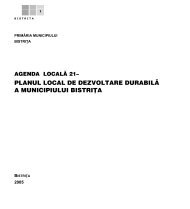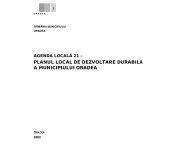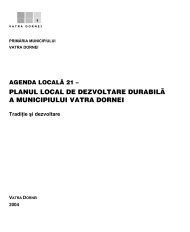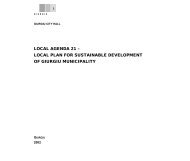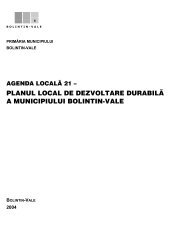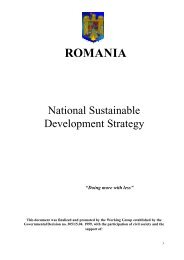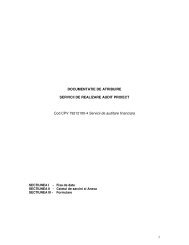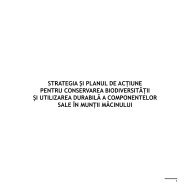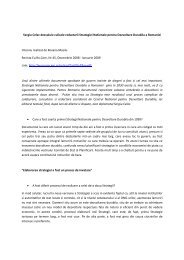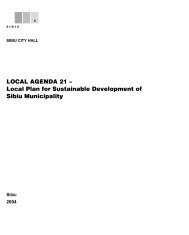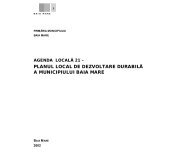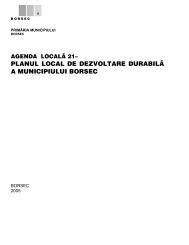local agenda 21 local plan for sustainable development of bistriþa ...
local agenda 21 local plan for sustainable development of bistriþa ...
local agenda 21 local plan for sustainable development of bistriþa ...
You also want an ePaper? Increase the reach of your titles
YUMPU automatically turns print PDFs into web optimized ePapers that Google loves.
Internal factors<br />
ANALYSIS: HUMAN CAPITAL<br />
48<br />
MUNICIPALITY<br />
Positive factors Negative factors<br />
Strengths:<br />
• Low cost <strong>of</strong> Internet connection;<br />
• Production <strong>of</strong> car batteries (no. 1 in<br />
Romania – ROMBAT);<br />
• Production <strong>of</strong> electric cables, plastic<br />
materials (increasing production<br />
volume);<br />
• Production <strong>of</strong> PVC tubes (leading<br />
position - TERAPLAST);<br />
• Key businesses at county level<br />
(ROMBAT- car battery; RAAL-car<br />
radiators; TERAPLAST – PVC tubes;<br />
ELECTROPLAST – cables) maintain<br />
employment and have no major<br />
problems<br />
• Most companies belong to the<br />
private sector (Romanian and mix<br />
capital)<br />
• Privatisation process finalised at<br />
county level;<br />
• Banking services are increasing (ebanking,<br />
international banking, card<br />
transfer);<br />
• Foreign investments such as LEONI<br />
and Roseyarns attract other potential<br />
investors in the area;<br />
• Housing construction (e.g. ANL)<br />
contributes to solving social<br />
problems;<br />
• 40ha available <strong>for</strong> industrial activities;<br />
Most <strong>of</strong> the city is connected to the<br />
water supply, sewerage, gas,<br />
telephone and cable networks.<br />
Weaknesses:<br />
• Local industrial products are not<br />
international brands;<br />
• Low competitivity on the<br />
international market <strong>for</strong> products<br />
with high added value;<br />
• Technological capability reaches<br />
only 4 th level (basic production, with<br />
eventual minor modifications) out <strong>of</strong><br />
a possible 7;<br />
• Lack <strong>of</strong> innovative production<br />
capacities (products with high<br />
added value or high innovative<br />
capacity <strong>for</strong> re-designing to the<br />
highest international standards);<br />
• In<strong>for</strong>mation technology is used <strong>for</strong><br />
middle-level production;<br />
• Lack <strong>of</strong> competitive engineering<br />
programmes <strong>for</strong> key processes and<br />
optimal management <strong>of</strong> resources<br />
through the system <strong>of</strong> non-quality<br />
costs<br />
• Only a few companies have<br />
implemented the ISO 9000 quality<br />
management standards and there<br />
is no interest in implementing the<br />
EFQM, with the sole exception <strong>of</strong><br />
SC ROMBAT SA;<br />
• The infrastructure needed to<br />
establish business incubators,<br />
technological and industrial parks is<br />
not properly developed.<br />
• Weak communication infrastructure<br />
(roads, networks)<br />
• Ecological problems: lack <strong>of</strong><br />
ecological waste deposit.<br />
• Research, innovation and<br />
technological transfer are<br />
insufficiently developed compared<br />
with requirements. The real<br />
collaboration between university<br />
and industry in research and<br />
<strong>development</strong> domain is not<br />
sufficiently active.<br />
• Lack <strong>of</strong> s<strong>of</strong>tware companies at<br />
county level;<br />
• The top 10 industrial sectors<br />
developed in the city (clothing,



